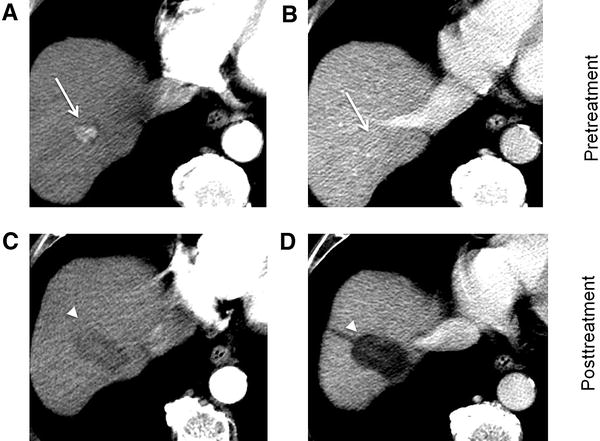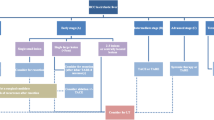Abstract
Surgical hepatectomy or liver transplantation are considered as curative treatment modalities for hepatocellular carcinoma (HCC). However, many patients are not surgical candidates at the time of diagnosis. Great improvements in locoregional therapies including local ablative therapy [radiofrequency (RF) ablation or ethanol ablation] and transarterial techniques (transarterial embolization or transarterial radioembolization) have made possible local control of HCC. For unresectable HCC, a targeted therapy with sorafenib may improve survival. Unlike treatment of other oncologic tumor, the locoregional therapies are mainstay in the treatment of HCC. Therefore, the application of classical criteria such as the World Health Organization (WHO) guideline may not be suitable for accurate treatment response assessment of locoregional therapies or targeted therapy of HCC. An understanding of the imaging features of post-treatment imaging after various treatment modalities for HCC is crucial for treatment response assessment and for determining further therapy. In this article, we review the role of various imaging modalities in assessing treatment response of locoregional therapies and the targeted molecular therapy.












Similar content being viewed by others
References
Lau WY, Lai EC (2008) Hepatocellular carcinoma: current management and recent advances. Hepatobiliary Pancreat Dis Int 7:237–257
Sauer P, Kraus TW, Schemmer P, et al. (2005) Liver transplantation for hepatocellular carcinoma: is there evidence for expanding the selection criteria? Transplantation 80:S105–S108
Rampone B, Schiavone B, Martino A, Viviano C, Confuorto G (2009) Current management strategy of hepatocellular carcinoma. World J Gastroenterol 15:3210–3216
Lau WY (1997) The history of liver surgery. J R Coll Surg Edinb 42:303–309
Zhang T, Ding X, Wei D, et al. (2010) Sorafenib improves the survival of patients with advanced hepatocellular carcinoma: a meta-analysis of randomized trials. Anticancer Drugs 21:326–332
World Health Organization (WHO) (1979) WHO Handbook for Reporting Results of Cancer Treatment. Geneva, Switzerland: WHO. WHO Offset Publication No. 48
Therasse P, Arbuck SG, Eisenhauer EA, et al. (2000) New guidelines to evaluate the response to treatment in solid tumors. European Organization for Research and Treatment of Cancer, National Cancer Institute of the United States, National Cancer Institute of Canada. J Natl Cancer Inst 92:205–216
Eisenhauer EA, Therasse P, Bogaerts J, et al. (2009) New response evaluation criteria in solid tumours: revised RECIST guideline (version 1.1). Eur J Cancer 45:228–247
Riaz A, Miller FH, Kulik LM, et al. (2010) Imaging response in the primary index lesion and clinical outcomes following transarterial locoregional therapy for hepatocellular carcinoma. JAMA 303:1062–1069
Forner A, Ayuso C, Varela M, et al. (2009) Evaluation of tumor response after locoregional therapies in hepatocellular carcinoma: are response evaluation criteria in solid tumors reliable? Cancer 115:616–623
Bruix J, Sherman M, Llovet JM, et al. (2001) Clinical management of hepatocellular carcinoma. Conclusions of the Barcelona-2000 EASL conference. European Association for the Study of the Liver. J Hepatol 35:421–430
Harry VN, Semple SI, Parkin DE, Gilbert FJ (2010) Use of new imaging techniques to predict tumour response to therapy. Lancet Oncol 11:92–102
Vossen JA, Buijs M, Kamel IR (2006) Assessment of tumor response on MR imaging after locoregional therapy. Tech Vasc Interv Radiol 9:125–132
Yu JS, Kim JH, Chung JJ, Kim KW (2009) Added value of diffusion-weighted imaging in the MRI assessment of perilesional tumor recurrence after chemoembolization of hepatocellular carcinomas. J Magn Reson Imaging 30:153–160
Youn BJ, Chung JW, Son KR, et al. (2008) Diffusion-weighted MR: therapeutic evaluation after chemoembolization of VX-2 carcinoma implanted in rabbit liver. Acad Radiol 15:593–600
Chen G, Ma DQ, He W, Zhang BF, Zhao LQ (2008) Computed tomography perfusion in evaluating the therapeutic effect of transarterial chemoembolization for hepatocellular carcinoma. World J Gastroenterol 14:5738–5743
Jackson A, Haroon H, Zhu XP, et al. (2002) Breath-hold perfusion and permeability mapping of hepatic malignancies using magnetic resonance imaging and a first-pass leakage profile model. NMR Biomed 15:164–173
Kim KW, Lee JM, Klotz E, et al. (2009) Quantitative CT color mapping of the arterial enhancement fraction of the liver to detect hepatocellular carcinoma. Radiology 250:425–434
Choi BI, Lee JM (2009) Advancement in HCC imaging: diagnosis, staging and treatment efficacy assessments: imaging diagnosis and staging of hepatocellular carcinoma. J Hepatobiliary Pancreat Sci 17:369–373
Sun HY, Lee JM, Shin CI, et al. (2010) Gadoxetic acid-enhanced magnetic resonance imaging for differentiating small hepatocellular carcinomas (< or = 2 cm in diameter) from arterial enhancing pseudolesions: special emphasis on hepatobiliary phase imaging. Invest Radiol 45:96–103
Llovet JM, Real MI, Montana X, et al. (2002) Arterial embolisation or chemoembolisation versus symptomatic treatment in patients with unresectable hepatocellular carcinoma: a randomised controlled trial. Lancet 359:1734–1739
Lo CM, Ngan H, Tso WK, et al. (2002) Randomized controlled trial of transarterial lipiodol chemoembolization for unresectable hepatocellular carcinoma. Hepatology 35:1164–1171
Lee HS, Kim KM, Yoon JH, et al. (2002) Therapeutic efficacy of transcatheter arterial chemoembolization as compared with hepatic resection in hepatocellular carcinoma patients with compensated liver function in a hepatitis B virus-endemic area: a prospective cohort study. J Clin Oncol 20:4459–4465
Riaz A, Lewandowski RJ, Kulik L, et al. (2010) Radiologic-pathologic correlation of hepatocellular carcinoma treated with chemoembolization. Cardiovasc Intervent Radiol 33:1143–1152
Jang KM, Choi D, Lim HK, et al. (2005) Depiction of viable tumor in hepatocellular carcinoma treated with transarterial chemoembolization: multiphasic helical CT with review of the previous serial CT images. Korean J Radiol 6:153–160
Kamel IR, Bluemke DA, Eng J, et al. (2006) The role of functional MR imaging in the assessment of tumor response after chemoembolization in patients with hepatocellular carcinoma. J Vasc Interv Radiol 17:505–512
Schima W, Ba-Ssalamah A, Kurtaran A, Schindl M, Gruenberger T (2007) Post-treatment imaging of liver tumours. Cancer Imaging 7 Spec No A:S28–S36
Kamel IR, Bluemke DA, Ramsey D, et al. (2003) Role of diffusion-weighted imaging in estimating tumor necrosis after chemoembolization of hepatocellular carcinoma. AJR Am J Roentgenol 181:708–710
Goshima S, Kanematsu M, Kondo H, et al. (2008) Evaluating local hepatocellular carcinoma recurrence post-transcatheter arterial chemoembolization: is diffusion-weighted MRI reliable as an indicator? J Magn Reson Imaging 27:834–839
Ibrahim SM, Nikolaidis P, Miller FH, et al. (2009) Radiologic findings following Y90 radioembolization for primary liver malignancies. Abdom Imaging 34:566–581
Gates VL, Atassi B, Lewandowski RJ, et al. (2007) Radioembolization with Yttrium-90 microspheres: review of an emerging treatment for liver tumors. Future Oncol 3:73–81
Atassi B, Bangash AK, Bahrani A, et al. (2008) Multimodality imaging following 90Y radioembolization: a comprehensive review and pictorial essay. Radiographics 28:81–99
Duke E, Deng J, Ibrahim SM, et al. (2010) Agreement between competing imaging measures of response of hepatocellular carcinoma to yttrium-90 radioembolization. J Vasc Interv Radiol 21:515–521
Salem R, Lewandowski RJ, Mulcahy MF, et al. (2010) Radioembolization for hepatocellular carcinoma using Yttrium-90 microspheres: a comprehensive report of long-term outcomes. Gastroenterology 138:52–64
Rhee TK, Naik NK, Deng J, et al. (2008) Tumor response after yttrium-90 radioembolization for hepatocellular carcinoma: comparison of diffusion-weighted functional MR imaging with anatomic MR imaging. J Vasc Interv Radiol 19:1180–1186
Gervais DA, Kalva S, Thabet A (2009) Percutaneous image-guided therapy of intra-abdominal malignancy: imaging evaluation of treatment response. Abdom Imaging 34:593–609
Rhim H, Goldberg SN, Dodd GD III, et al. (2001) Essential techniques for successful radio-frequency thermal ablation of malignant hepatic tumors. Radiographics 21 Spec No:S17–S35; discussion S36–S19
Goldberg SN, Gazelle GS, Compton CC, Mueller PR, Tanabe KK (2000) Treatment of intrahepatic malignancy with radiofrequency ablation: radiologic-pathologic correlation. Cancer 88:2452–2463
Lim HK, Choi D, Lee WJ, et al. (2001) Hepatocellular carcinoma treated with percutaneous radio-frequency ablation: evaluation with follow-up multiphase helical CT. Radiology 221:447–454
Dromain C, de Baere T, Elias D, et al. (2002) Hepatic tumors treated with percutaneous radio-frequency ablation: CT and MR imaging follow-up. Radiology 223:255–262
Goldberg SN, Grassi CJ, Cardella JF, et al. (2009) Image-guided tumor ablation: standardization of terminology and reporting criteria. J Vasc Interv Radiol 20:S377–S390
Park MH, Rhim H, Kim YS, et al. (2008) Spectrum of CT findings after radiofrequency ablation of hepatic tumors. Radiographics 28:379–390; discussion 390–372
Ozkavukcu E, Haliloglu N, Erden A (2009) Post-treatment MRI findings of hepatocellular carcinoma. Diagn Interv Radiol 15:111–120
Chopra S, Dodd GD III, Chintapalli KN, et al. (2001) Tumor recurrence after radiofrequency thermal ablation of hepatic tumors: spectrum of findings on dual-phase contrast-enhanced CT. AJR Am J Roentgenol 177:381–387
Assumpcao L, Choti M, Pawlik TM, Gecshwind JF, Kamel IR (2009) Functional MR imaging as a new paradigm for image guidance. Abdom Imaging 34:675–685
Schraml C, Schwenzer NF, Clasen S, et al. (2009) Navigator respiratory-triggered diffusion-weighted imaging in the follow-up after hepatic radiofrequency ablation-initial results. J Magn Reson Imaging 29:1308–1316
Pupulim LF, Hakime A, Barrau V, et al. (2009) Fatty hepatocellular carcinoma: radiofrequency ablation–imaging findings. Radiology 250:940–948
Cho YK, Kim JK, Kim MY, Rhim H, Han JK (2009) Systematic review of randomized trials for hepatocellular carcinoma treated with percutaneous ablation therapies. Hepatology 49:453–459
Sironi S, De Cobelli F, Livraghi T, et al. (1994) Small hepatocellular carcinoma treated with percutaneous ethanol injection: unenhanced and gadolinium-enhanced MR imaging follow-up. Radiology 192:407–412
Ebara M, Kita K, Sugiura N, et al. (1995) Therapeutic effect of percutaneous ethanol injection on small hepatocellular carcinoma: evaluation with CT. Radiology 195:371–377
Rimassa L, Santoro A (2009) Sorafenib therapy in advanced hepatocellular carcinoma: the SHARP trial. Expert Rev Anticancer Ther 9:739–745
Horger M, Lauer UM, Schraml C, et al. (2009) Early MRI response monitoring of patients with advanced hepatocellular carcinoma under treatment with the multikinase inhibitor sorafenib. BMC Cancer 9:208
Maksimovic O, Schraml C, Hartmann JT, et al. (2010) Evaluation of response in malignant tumors treated with the multitargeted tyrosine kinase inhibitor sorafenib: a multitechnique imaging assessment. AJR Am J Roentgenol 194:5–14
Acknowledgments
We thank Bonnie Hami, M.A. for her editorial assistance. This work was partly supported by Basic Science Research Program through the National Research Foundation of Korea (NRF) (Grant No. 800-20100430).
Author information
Authors and Affiliations
Corresponding author
Rights and permissions
About this article
Cite this article
Kim, K.W., Lee, J.M. & Choi, B.I. Assessment of the treatment response of HCC. Abdom Imaging 36, 300–314 (2011). https://doi.org/10.1007/s00261-011-9683-3
Published:
Issue Date:
DOI: https://doi.org/10.1007/s00261-011-9683-3




